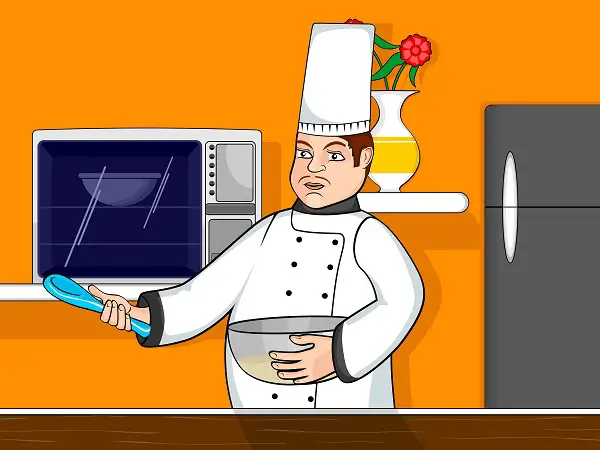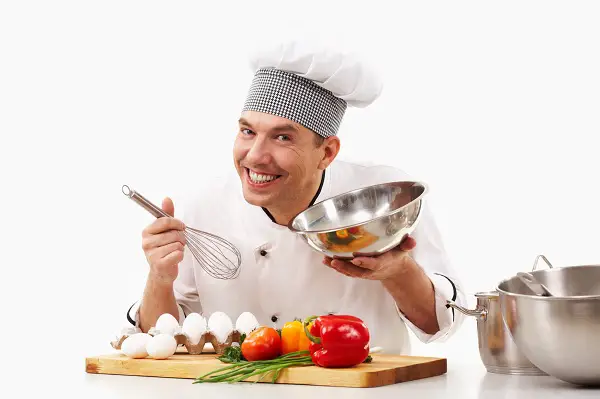The restaurant business is one that runs on delegation, and because of that, a clearly defined hierarchy is imperative to success.
While there is a hierarchy in the front of the house, it makes more sense to focus on the kitchen because the hierarchy of a professional kitchen is less familiar when compared to that of other business types such as retail.
Chef
At the top of the kitchen hierarchy is the chef.
The chef is the leader of the kitchen; they’re in charge of menu creation, ordering, staffing decisions, and communication between the kitchen and the front of house.
They can often be seen expediting, which means they stand opposite the line cooks and manage the pick.
The pick is the list of items that are going to be imminently walking out of the kitchen to the customer.
It’s also common to find the sous chef or even the lead line cook expediting, depending on the distribution of duties specific to the restaurant.
Sous Chef

Next in line is the sous chef.
Sous means “under” in French, and their position is second to the chef.
They assist in many of the responsibilities of the chef, usually with a particular focus on delegating tasks to the cooks, ensuring all prep is done for the day (both correctly and on time), and placing orders when necessary.
Right below the sous chef in the hierarchy is the lead line cook.
Some restaurants do not specify a lead line cook, but when there is one they tend to take on a few of the sous chef’s responsibilities, namely delegating tasks and handling prep.
Line Cooks

At the middle of the rung are the line cooks, who can also be further broken down into a hierarchy of their own.
From a management perspective, these cooks are on about the same level. From the kitchen perspective though, they range in importance and role.
The slightly higher up positions tend to be saute and grill; these positions require greater cooking knowledge and speed, as well as time management.
The lower level positions those such as fry, pizza, and garde manger, which is sometimes separated into salads and desserts.
These positions tend to include quick and easy dishes that are less time-sensitive.
Dishwasher
Finally, in many kitchens, the dishwasher and prep cooks (often the same people) fall on the lowest level of the hierarchy.
Don’t take this to mean they’re unimportant–these are the most important people in the kitchen!
They make sure the tedious tasks that are absolutely necessary for service are completed, and they often do it for less compensation.
Be nice to your dishwashers!
Why Do You Need It?
That sums up what the kitchen hierarchy is, but why do you need it?
In short, kitchens tend to devolve into complete chaos quite easily. If nobody is ensuring everything necessary is done, then some tasks will inevitably be forgotten or ignored until the last minute, which can throw service off-kilter and create a stressful situation for everyone.
The amount of work involved in running a kitchen is no joke; one person cannot do it all, so delegation becomes key.
If nobody is in charge of delegating, or if the person in charge is only tangentially involved (like a front of house manager), the full scope of work to be done won’t be seen by the people who need to do the work.
Line cooks, no matter how good at their job, have only so much time to prep their stations and get ready for service.
They cannot do all that if they are also in charge of putting away orders, prepping all the food for service, doing dishes, and keeping the kitchen clean.
A chef or sous chef with no line cooks may see the work to do, but it will be too much for them.
The dishwashers and prep people don’t have the experience and skills to make sure everything they need to do for the line is ready.
And the front of house staff, be it managers or even servers, don’t understand how the kitchen works well enough to effectively lead it.
In Conclusion
The kitchen hierarchy is necessary to have an efficient, prepared, and happy kitchen.
If everyone knows their role and performs it to the best of their ability, the entire restaurant will reap the benefits.
The food will be better, there will be fewer issues with running out of the product, and the time from order to receiving food will be shorter.
Everyone wins with a well-run kitchen, from the dishwashers to the customers to the managers.
Leave Feedback: Was this article helpful?

